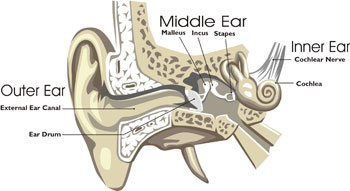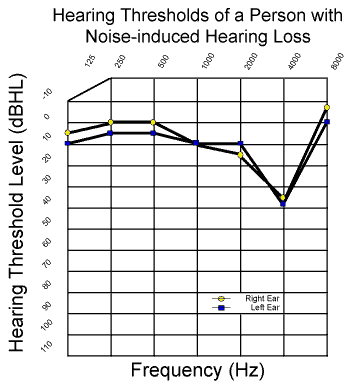Noise-Induced
Hearing Loss
What Causes Hearing Loss?
Although hearing loss can result from aging
and certain medical conditions, the main cause of hearing loss
for workers is excessive
noise in the workplace. When workers are exposed to loud
levels of noise over a period of time, they can experience what
is called noise-induced hearing loss. Thousands of workers
already have noise-induced hearing loss, because many workplaces
did not adequately control noise in the past. The situation has
improved since workplace noise regulations were passed thirty years
ago. Nonetheless, millions of workers are still at risk for hearing
loss.
It is important to recognize
that noise-induced hearing loss is cumulative. This means that
exposures to loud levels of noise off the job – gunfire,
power tools, and loud music - can also contribute to a worker’s
overall hearing loss.
How is Noise Measured?
The loudness or intensity of sound is measured in decibels (dB).
The decibel scale is used to describe a wide range of sound levels.
On the scale, a soft whisper would measure 30 dB, a rock concert
would measure about 100 dB and noise at a rocket launch pad during
takeoff is about 180 dB. For most people, hearing loss can occur
from prolonged exposure to sound levels of 85 dB (approximately
the sound of a loud vacuum cleaner) and above. In practical terms,
noise may damage your hearing if:
 |
 |
You
have to shout over background noise to make yourself heard |
| |
 |
You experience
pain, ringing in your ears or temporary loss of hearing after
exposure to noise |
|
FIGURE 1: Diagram
of Human Ear |
How Does Noise
Lead to Hearing Loss?
Sound waves travel through the ear canal – vibrating the eardrum, which
passes the vibration through the middle ear along to the cochlea, the snail-shaped
part of the inner ear. The tiny hair cells lining the cochlea bend in response
to vibration. This transmits a signal to the brain (see
Figure 1).
Hearing loss is like a shortcut path on grass. When you first use
the path, your feet bend the grass down and it takes a while for
the blades to spring up after you pass. The more you walk on the
path, the longer it takes for the grass to recover. And what happens
if you repeatedly walk on the same shortcut path for days, weeks
or years? The grass will eventually wear down. Permanent hearing
loss occurs when the hair cells in the cochlea that bend in response
to vibration are so damaged they cannot recover, just like the grass
that has been trampled over too many times. At first you may experience
a temporary loss of hearing from which you recover by the next day
when you return to work, but over time the loss of hearing may become
permanent.
What are the Symptoms of Hearing
Loss?
Many people with noise-induced hearing
loss complain of gradual deterioration in hearing. A common complaint
is difficulty in understanding speech, especially if there is competing
background noise. Muffling of certain sounds may also occur as well
as tinnitus (a ringing sound in the ear).
How is Hearing Loss Measured?
Hearing is usually tested using an audiometer. This device generates
sound tones at different frequencies (measured in Hertz). Typically
you sit in a booth or closed room and are asked to listen to a tone
at a particular frequency at varying decibel levels. The procedure
is repeated at several different frequencies. The decibel level at
which you first hear a particular frequency is plotted on a graph
called an audiogram. The right ear and left
ear are charted separately. The louder the volume has to be turned
up for you to hear a particular tone, the more hearing loss there
is in that test frequency. An example of an audiogram is shown
below (see Figure 2). The further the line is below “0,” the
greater the impairment. A hearing loss of 25 dB or more is normally
considered hearing impairment.
Can a Doctor Tell Whether My Hearing
Loss is from Noise Rather than Aging?
When hearing loss has occurred because of exposure to noise, the
audiogram will show that the individual has lost the most hearing
at the 4,000-Hertz frequency. This hearing loss will appear as a
notch, or dip, in the audiogram at 4,000 Hertz frequency, as shown
on the graph below. In addition to your occupational and personal
history, this is how the doctor can determine from the audiogram
that your hearing loss is related to noise.
|
FIGURE 2: Audiogram
Showing Noise-Induced Hearing Loss |
If I Already Have Hearing Loss,
What Should I Do?
Once you experience hearing loss, you
need to protect yourself from further damage to your hearing. The
more you are exposed to hazardous levels of noise, the more hearing
loss you are likely to experience. To prevent further damage, you
should take steps to reduce your noise exposures both on and off
the job. Start by talking to your employer and local union about
evaluating the noise levels at work. Remember, once hearing loss
occurs, it is permanent and irreversible.
Is Hearing Loss Compensable Under the State Workers’
Compensation
system?
All states do consider work-related
hearing problems compensable diseases under their workers’ compensation
laws. You may be able to get payment for medical treatment
including medical devices such as hearing aids as well as reimbursement
for travel costs for medical evaluation and care. You may also
be able to get a lump sum payment for permanent hearing loss,
equal to a certain number of weeks of pay called a Schedule Loss Award.
Check with your WHPP Local Coordinator for the specifics of the
state you live in.
|




